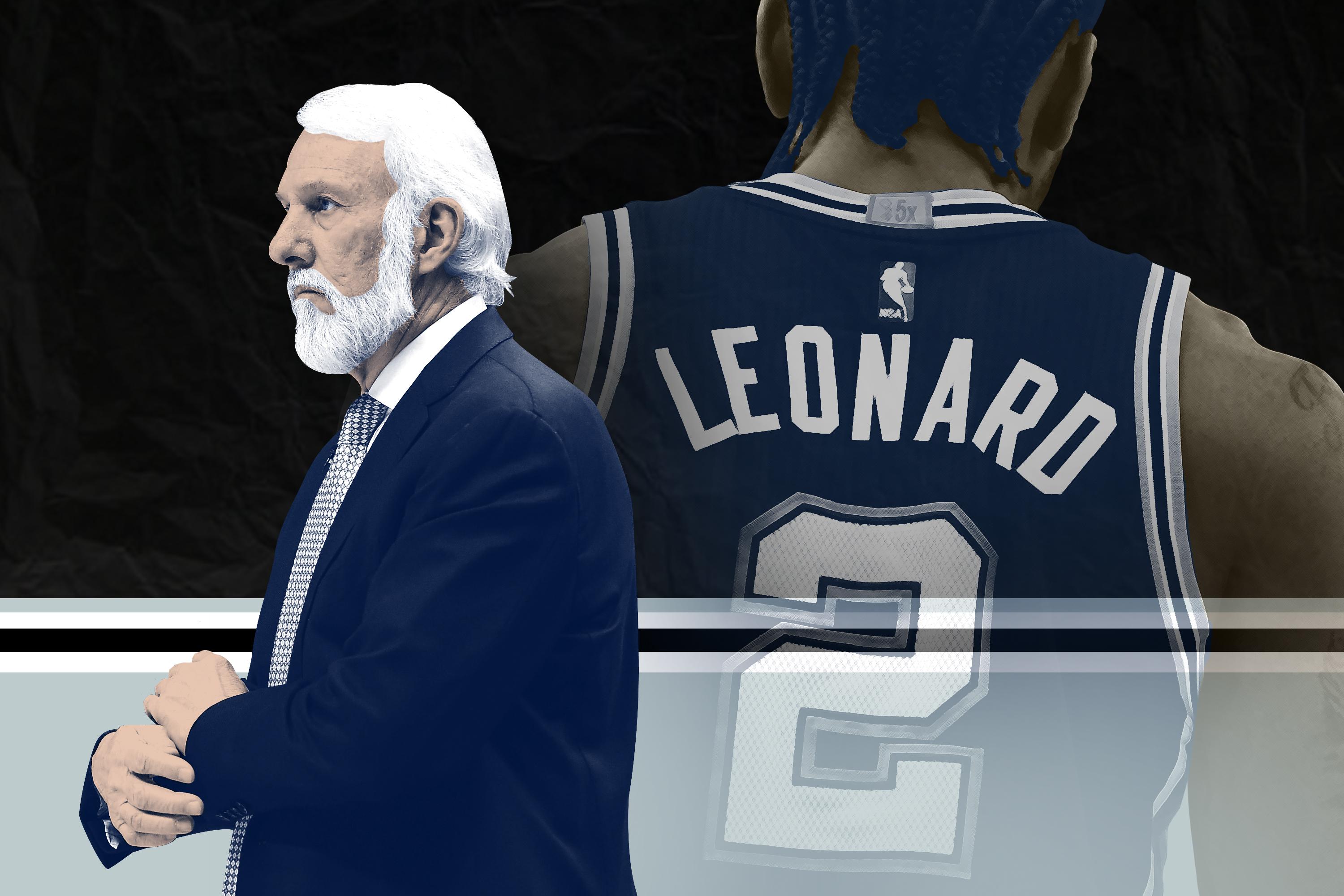
This piece has been updated after publication with more information.
The Spurs are as much a mausoleum as they are a basketball institution, a monument to the ancient ways and a barometer for the shifts in style and attitude that have come upon the league. Through the past two decades, there has been no greater constant in the NBA. San Antonio’s infrastructure has survived retirements and rule changes, and stood its ground against gamebreakers as disparate as Shaquille O’Neal and Steph Curry. Gregg Popovich has been the longest-tenured coach with the same team in all four major American sports leagues for more than half a decade. By 2020, when his contract is up, Popovich will be the longest-tenured coach in NBA history. He made his NBA head-coaching debut with the Spurs in 1996; more than a third of the league’s active head coaches began their current stints in 2016.
Because of the constant turnover we see in front offices and coaching seats, continuity has a low threshold for clearance. Coaches are expected to instill culture in a year. By Year 2, players are expected to “buy in,” and their development should start to manifest in the image of the coach’s prescription. Any longer, and suddenly seats get hot. It’s a cycle built on faith, but faith doesn’t have a predetermined growth pattern.
What Popovich has over any other coach in American professional sports is an uninterrupted backlog of data and lived experience spanning more than two decades. Compared with every other franchise, the Spurs have established continuity that runs at a near-atomic level. He’s coached prototype models of today’s most effective stars years before they entered the league, he’s built the template for the modern role player, and he’s adjusted to countless situations in his 1,953 total games. Popovich’s strategy sessions may as well involve him at a table playing chess, with the pieces on the board all specters of his past teams pointing the way forward. It’s the Hauntology of the Spurs’ ghost dynasty: The future is just the present coexisting with the past.
The key to the 2017-18 Spurs to this point is not unlike the key to the team of 1997-98. Popovich deploys multifaceted big men at the 4 and 5, each one more than capable of doing the other’s job, effectively blurring their responsibilities to create a fluid exchange of power. LaMarcus Aldridge and Pau Gasol are not Tim Duncan and David Robinson, but they function similarly on offense, albeit retrofitted to the modern landscape. When both players are on the floor, one will start off at the top of the arc to set the pick that initiates an action, and the other will likely park in the corner as the play develops. Both Aldridge and Gasol are shooting over 38 percent from 3.
What starts out as a spread floor soon compresses. The Spurs run plays to get the ball in the post more than any other team in the league, and the low block remains, all these years later, the hub of their offense. The painted area plays an essential role in not only creating shots around the rim, but shots on the perimeter; some of the Spurs’ most iconic sets turn the midrange area into a high-density, high-traffic area for the defense through the presence of a post player and several back screens, which leaves blind spots out on the perimeter.
Aldridge has always been good at establishing post position, but playing alongside San Antonio’s swarming, roving cutters has made it even easier. Now add in the fact Gasol might be the best post-entry passer in the league, a skill honed in 17 years of playing the high-low game. Gasol, at 7 feet tall, has a perfect vantage when operating at the top of the arc and drops passes with his gangly arms at angles few others can even attempt. On defense, while neither is well-suited to protect the rim or roam on the perimeter, the Spurs as a team do a good job of rotating and providing help to whoever has the ball by ignoring non-threats on the perimeter; they try to keep their two bigs off any islands. An Aldridge-Gasol front line should not be as effective as it is; the Spurs outscore opponents by 11 points per 100 possessions when the two share the court, and they’ve spent around half of their total minutes together. The team as a whole is a top-five defense, and its performance this season has been augmented by a litany of aging stalwarts and near-anonymous contributors. The Spurs are the Spurs, same as it ever was.
Or at least that’s the view through the lens of selective amnesia, which has been self-imposed by the Spurs organization for the past two months. The Spurs are not the Spurs—or at least not the Spurs that stand a chance against the league’s very elite. Not without the player who last season completely changed the paradigm of what a Popovich-led team could be. “A team just has to play in a sense like he doesn’t exist,” Popovich told reporters last month. “Nobody cares if you lost a good player, right?”
Pop went back to his roots to cobble a potential 3-seed out of this team, but there’s still a ghost on the chessboard that hasn’t been moved.
Hundreds of players have entered Popovich’s orbit in his 22 seasons, and many of them filled preexisting molds that have historically served as tentpoles for San Antonio’s success. When was it that you realized Kawhi Leonard didn’t fit any of them? When he had the potential to warp Popovich’s system from the inside? Maybe you’d point to his MVP moment against the Rockets in early March, and the 14-second 3-and-D sequence that had Manu Ginobili, one of the five greatest Spurs of all time, in shambles, shaking his head and propping his arms in surrender-cobra position, befuddled by what Kawhi had just done.
I would point to Game 4 of the Grizzlies-Spurs first-round series last season, which would be my pick for best game of 2017. Leonard scored 21 of San Antonio’s final 25 points of the game. He demanded clear-outs. He made impossible defensive plays all by himself. All of a sudden, the Spurs had in their arsenal the most efficient version of Kobe that never existed. It was unlike anything we’d ever seen from the Spurs in the Popovich era. I remember being dumbstruck; I recall my brother, a converted Spurs fan, feeling unsettled: The team had never looked like hapless bystanders before, they’d never been so dependent on a single player’s greatness. The Spurs lost that game, 110-108, but the results weren’t as important as what Leonard’s performance signaled. Popovich has never had this kind of dynamic perimeter scorer before; Ginobili had the talent, but he was always dancing along the edge of collapse. Leonard’s performance was brimming with a calming reassurance. Discovering this unleashed version of Leonard added something new (new!) to the Spurs’ decades-long continuity—it offered a break-in-case-of-emergency safety valve.
So maybe it was right for Popovich to force his team to forget it ever existed. The Spurs have doubled down on their time-tested ways, and it’s led to a top-three record in the West, behind two loaded superteams in Houston and Golden State. San Antonio has done exactly what it’s needed to in Leonard’s absence, and now, 25 games into the season, when most teams are starting to figure out rhythms and rotations, the Spurs will have to prepare for their deus ex machina’s imminent arrival. They’ll face their own version of a superteam conundrum soon enough. The San Antonio Express-News reported Thursday that Kawhi Leonard’s long-awaited season debut could come Saturday against the Suns. [Update: ESPN's Adrian Wojnarowski and Michael C. Wright have reported that the team is now targeting a Tuesday return against the Mavericks.]
How Leonard’s presence affects Aldridge’s performance going forward will be the most important development of the regular season; Aldridge is having a career year as the focal point of the Spurs offense, and San Antonio might elect to keep him at the center of the action until Leonard works his way back into optimal conditioning. Aldridge will likely play in space more often as the pop-or-roll man in pick-and-rolls, which should be more effective this season with his added range. The Kawhi who posted a 31.1 usage rate last season probably isn’t the Kawhi we’ll see right out of the gate whenever he makes his first appearance. It will be interesting to see if Leonard reacclimates simply by playing as a previous version of himself, cutting off the ball, spotting up, and getting plays called for him in the post. Pop may have erased Leonard’s presence from the team to cultivate a sense of self-sufficiency in his absence, but the sets he’s run recently to free up Kyle Anderson and Rudy Gay on the block suggest Pop’s well underway in finding ways to incorporate Leonard seamlessly.
“I’m going to continue being myself. I feel like Pop and the coaching staff will figure that out. I’m not on the coaching staff. That’s not my mind-set. Teams [figure it out] all the time,” Aldridge told reporters Thursday. “Miami had a big three. Golden State is doing it now. So, it’s not difficult to have two or three guys being dominant out there.”
Down the line, Pop’s vision for Kawhi this season may come down to where he’s slotted positionally. Gay and Anderson have both seen time splits at the 3 and 4 somewhere between 50-50 and 60-40. Leonard played nearly all of his minutes at small forward last season, but saw a significant jump in minutes at the 4 in the playoffs. Aldridge and Gasol work wonders in the 82-game season because most teams have weaknesses that Pop can easily exploit within a team concept. But against teams that have shooters at every position, it’s much more difficult to call for reinforcements, lest they give up an open 3. Kawhi can neutralize a lot of that by himself, which makes Pop’s small-ball experimentation (or lack thereof) throughout the season something to watch.
This will sound strange, but the Spurs will be one of the most interesting teams in the league going forward. After 22 seasons of excellence, you’d think Popovich and Spurs fans have seen it all, but they’ve never had a savior drop in midseason. Kawhi changes everything, and with all the reps the team has had without him, the Spurs could be better equipped to take on the superteams forming around them than last season (ask a Spurs fan how they’d think the Western Conference finals would’ve gone last season if Leonard didn’t get hurt, and it’ll be clear this is no faint praise). It’s been one of Pop’s best coaching performances of his career, but the history lesson that the Spurs have put on in the past 25 games is about to be obsolete. Kawhi’s mere presence conjures a different future.

